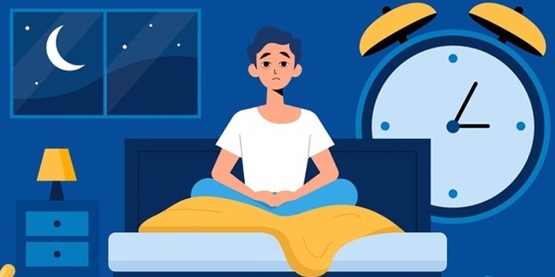
INSOMNIA
It is the name of the disorder in which it becomes difficult to fall asleep and stay asleep, or to wake up shortly after going to sleep. It has been observed that insomnia, which is one of the common disorders among sleep problems, becomes a syndrome when it becomes permanent and affects the quality of life badly. Sleep problems that do not last for a month or more may need to be treated with professional help. Low energy needed during the day is one of the biggest problems for people who make insomnia a life routine and struggle with this disease. Because people with insomnia feel weak, tired and exhausted throughout the day from the moment they wake up.
HYPERSOMNİA
Hypersomnia, defined as excessive desire to sleep, is the occurrence of repetitive sleep stages or falling asleep in the same day, although the main sleep stage lasts 7 hours or more. Even if patients get enough sleep without interruption at night, they feel the need to sleep with sleep attacks that come during the daytime. In hypersomnia, patients complain of not being able to rest no matter how much they sleep. Hypersomnia disease, in which patients have difficulty in being fully awake after waking up, is examined in three different categories as narcolepsy, idiopathic hypersomnia and Kleine-Levin syndrome. All three categories are common sleep disorders associated with hypersomnia.
NARCOLEPSY
Narcolepsy, or sleeping sickness, as it is known among the people, is a chronic sleep disorder characterized by sleepiness and sudden sleep attacks at abnormal times. Individuals who are victims of narcolepsy have difficulty in staying awake for a long time to the environmental conditions they are in and may encounter great difficulties in daily life. Narcolepsy is generally defined as two types. In some cases, it is possible to see cataplexy, a sudden loss of muscle tone that can be triggered by strong emotions, alongside narcolepsy. The type of narcolepsy that occurs with cataplexy is called type 1 narcolepsy. It is characterized by a clinical tetrad consisting of sudden onset, recurrent, non-suppressing sleep attacks, cataplexy (sudden and short-term partial or complete loss of tone in voluntary muscles in which the state of consciousness is preserved), sleep paralysis during sleep-wake transition, and hypnagogic/hypnopompic hallucinations. The last recognized symptom of narcolepsy is frequent nighttime interruptions with brief awakenings.
SLEEP APNEA
It is defined as cessation of breathing for at least 10 seconds during sleep, and hypopnea is defined as a decrease in oxygen saturation of at least 4% and arousal for at least 10 seconds, together with a 50% decrease in respiratory volume. Sleep apnea can be defined as the cessation of breathing during sleep.
In sleep apnea syndrome, temporary suffocation lasting for a few seconds can occur during sleep. During this suffocation, the oxygen level in the blood drops, allowing the brain to wake up. The brain wakes the body to let the respiratory functions cease. People with sleep apnea may wake up several times during the night, and those whose sleep is often interrupted cannot remember the next day. This situation causes a feeling of fatigue and weakness in the person in repetitive time periods. Sleep apnea syndrome should be investigated in people who think that they have slept for a sufficient amount of time and wake up tired and in people who are sluggish and sleepy during the day. Symptoms that dominate the clinical picture are snoring, witnessed apnea and excessive daytime sleepiness. Waking up in the morning tired and restless, fatigue and related traffic or work accidents, headache, weight gain or inability to lose weight, cognitive disorders such as forgetfulness, memory defects, attention deficit disorder, personality changes, aggression.
SLEEP TERROR
Although sleep terrors or night terrors are usually seen in children, it is a type of disease that can sometimes occur in adults. Sleep terror is when children wake up screaming, frightened or shaking within 1 to 2 hours after falling into a deep sleep. Sleep terror, also known as night terrors, is a sleep disorder. This condition can often be paired with sleepwalking. It is a disorder seen in NREM sleep stages 3 and 4, in which there is screaming and crying with sudden awakening, intense fear accompanied by autonomic symptoms such as palpitation, sweating, mydriasis, facial flushing, and behavioral changes. The person may also display violent behavior. Sleep terrors are thought to be associated with arousal and sympathetic nervous system activation in response to a frightening image. During the attacks, which last an average of 15 minutes, the person is hardly awakened and there is complete or partial amnesia related to the attack. It is estimated that the prevalence of sleep terror, which is seen with a frequency of 1-6% among children, is less than 1% in adults. First-degree relatives of people with sleep terrors have a 10-fold increased risk of parasomnia, the inheritance pattern is unknown. Treatment is the same as for other NREM parasomnias.
SLEEP-RELATED EATING DISORDER
It is a disorder in which attacks of involuntary eating and drinking are seen during sleep. Consumption of inedible or dangerous substances, engaging in dangerous behaviors to obtain food, symptoms of insomnia due to sleep disruption, and loss of appetite in the morning may accompany the clinical picture. It leads to additional health problems due to the consumption of high-calorie foods. Waking up to eat appears to be triggered by a learned behavior, not by actual hunger or thirst. There is complete or partial amnesia associated with the attack and no abnormal eating behavior is expected during wakefulness.
